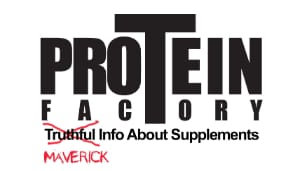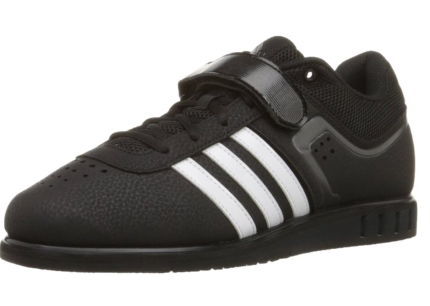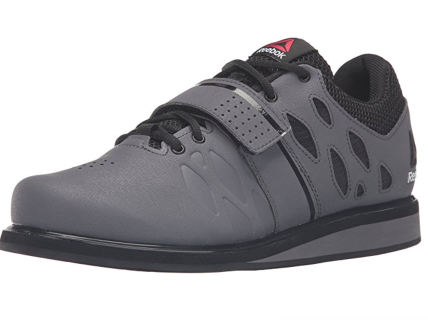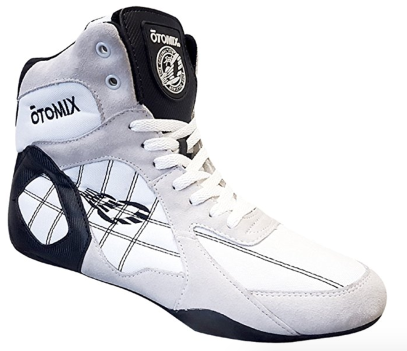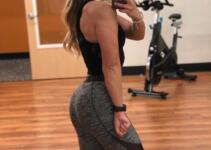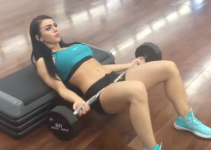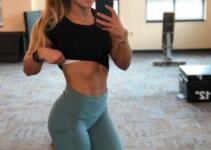It is important to have the right tool for the job, and this holds true for your athletic equipment too. Having the right equipment for your sport can make the difference between a good workout and a disappointing one. Making the wrong choices can diminish your performance and put you at risk of sports injuries. When you’re recovering and rehabbing yourself from an injury, you’re not training. Whether you are lifting weights as strength training for other sports or you are involved in competitive weightlifting and powerlifting, the right pair of powerlifting shoes is absolutely essential for your safety and performance in the gym.
One of the biggest mistakes you can make is to use just any pair of athletic shoes you find on the shoe rack. The average sneaker or gym shoe is in fact a running shoe, and is optimized for the needs of a runner’s feet. That means thick shock absorbing layers to cushion the foot from the impact of hitting the road.
When you are lifting weights, you are standing stationary or taking a few steps. As a result, the features that make a good running shoe will reduce your weightlifting performance and can actually endanger yourself and others by compromising your footing. Instead, good weightlifting or powerlifting shoes have three major elements: a hard sole, a no-slip traction surface, and a snug fit.
The hard sole is essential for enabling you to effectively transfer force into the floor so that you can lift heavier weights. When you are lifting weights, your feet are your foundation, and if you are experiencing compression in the soles of your shoes, you will lose your ability to lift effectively. Early weightlifting shoes & powerlifting shoes had wooden soles, but most modern manufacturers use hard plastic soles in their weightlifting and powerlifting shoes.
The no-slip surface ensures that you have a sound footing during all parts of weightlifting exercises, from the moment you squat through to returning the weights to the floor or their stand. This is an important safety consideration for all free weight work, and is absolutely critical for Olympic-style lifts and overhead movements, in which losing your footing could put yourself and others in danger.
Powerlifting shoes with a snug fit ensures that your foot is securely supported throughout its length from heel to toe. Just as you do not want your shoe slipping on the floor, you do not want your foot sliding within the shoe. Because snugness of fit is so critical to performance and safety in weightlifting sports, most specialized weightlifting shoes are laced all the way down to the toe, and often include straps over the laces to further tighten the fit.
Many beginning weightlifters and people doing weight work for strength training often balk at the idea of purchasing specialized weightlifting shoes. Often they will ask whether barefooters or minimalist shoes similar to old-school tennis shoes will work just well. Both of these types of shoes have hard soles with a minimum of the thick cushioning which make the typical running shoe unsuitable for weightlifting sports.
However, barefooters and minimalist shoes also lack padding to protect the foot from blows from above. This means that your feet are not effectively protected from injury from having a weight dropped onto them. While dropping weights on one’s toes is a common sight gag in comedy, in real life dropping heavy plates on an unprotected foot can result in serious, even life-changing injuries. For this reason, many gyms prohibit barefooters and other minimalist shoes in their weight rooms, just as they prohibit weightlifting in bare feet.
Specialized weightlifting & powerlifting shoes come in two types. Some have flat soles, while others have a raised heel. One of the quickest ways to get a heated debate going in weightlifting circles is to ask about the pros and cons of each type. Some weightlifters swear by heel lifts, while others insist that raised heels can actually hold you back.
The raised heel enables deeper squats by permitting a better range of motion in the ankle. It also helps with maintaining a straight torso for the best, most effective lift, and helps to control knee valgus. Valgus collapse can be a problem for anyone, especially someone who received substandard instruction when first beginning and developed poor posture habits. However, knee valgus is a particular problem for women weightlifters for both physiological and psychological reasons. Women have a wider hip angle as a result of the pelvic shape necessary for childbirth. Furthermore, women come under strong social pressure to “sit like a lady” and thus develop deep inhibitions against spreading their legs.
However, while a weightlifting shoe with a raised heel can help beginning weightlifters develop good form, there is evidence that it can actually become a hinderance as one becomes more proficient. Some trainers have compared the problems with using raised heels exclusively to the difficulties that can arise when you only practice with your wrists wrapped or with a belt. Yes, you help ensure that you don’t overstrain and injure your wrists or lower back, but if you don’t develop sufficient strength to lift without those supports, you will never reach your full potential.
As further support for the notion that raised heels are good for beginners but something to move beyond, such people will point out that most professional powerlifters use shoes with flat heels. Because they do not have that additional inch or so under their feet, they do not need to bend as deeply in their squats. Additionally, they have developed their strength to the point most of them are using their hips and their gluteal muscles as much as their knees and quadriceps.
There is also the argument that valgus collapse is not as big a problem as many people would make it. Rather than being a performance issue, avoiding knee valgus is more of an aesthetic matter of good form. People who make this argument will often point out the number of competitive powerlifters who bring their legs together when lifting but still win competitions on a regular basis and beat athletes who display impeccable form.
To further confuse the issue, there are the people who argue that flat vs. raised heels is less a matter of where you are in your athletic career than what kinds of weightlifting exercises you are performing. According to this argument, both raised and flat heels are valuable equipment throughout your weightlifting or powerlifting career, but each is more suitable to certain kinds of lifts. For instance, raised heels are apt to help your performance in the front squat, the high bar back squat and various Olympic-style lifts and overhead movements, because they give you a better range of ankle movement. By contrast, flat heels allow a wider stance so that you can “sit back” in your squat to better engage your hips and gluteals. As a result, flat heels are better suited to deadlifts and Pendlay rows.
Whether you decide to go with flat or raised heels powerlifting shoes or get a pair of each for doing different types of lifts, your next choice is going to be what brand to buy. When you go into your local sporting goods store’s shoe department, you are apt to be confronted with a variety of brands of shoes that are marketed as weightlifting or powerlifting shoes. Many people swear by their favorite brand, whether it is Adidas Powerlift, Reebok Lifters, or the classic Converse Charles Taylor high-tops. However, it is not necessary to get the most expensive pair of weightlifting shoes on the rack, whatever the sales associate may tell you. Often they are as much interested in improving the store’s bottom line as your athletic performance. However, don’t go to the other extreme and buy the cheapest pair of powerlifting shoes on the basis of price alone. Bottom-end shoes are often made to an inferior standard, are apt to wear out rapidly, and won’t give you the performance of a better shoe. Inferior quality powerlifting shoes can actually put you at greater risk of injury.
To get the best value for your athletic shoe budget, focus on quality and fit. Examine the shoes inside and out for high-quality materials and solid workmanship. Pay particular attention to the seams. Are they even and steady, or do they appear to have been sewn hastily? Seams are one of the major wear points, and their visibility make them a good indicator of the overall quality of a shoe’s manufacture.
When you are satisfied you are looking at a solid shoe of high-quality materials and workmanship, try on a pair. Because snug fit is so critical in a weightlifting or powerlifting shoes, it is essential to try on both shoes of the pair you are considering. You don’t want to buy a pair that fits your right foot fine, then get to the gym and discover the other shoe won’t fit your left foot no matter how carefully you adjust the laces and straps.
Once you have the pair on, see how they fit as you shift your balance through squats and other movements of weightlifting. You want to make sure your new purchase will support all parts of your feet throughout your weightlifting workout, with no surprises. Some stores may even let you try some lifts with their display free weights to ensure you have the best possible fit.
Although most weightlifters and powerlifters still buy their shoes at a bricks and mortar sporting goods store, there are a growing number of websites that offer athletic shoes online. While retailers such as Amazon.com often offer better prices for the same name-brand shoes, they cannot offer the opportunity to try on their shoes before purchasing them. If you do want to go with an online retailer, for instance if you have found a shoe that works for you and need to buy a second pair, be sure to read and understand their returns policy. Sometimes shoe sizes are mis-marked, and there is always the possibility of being shipped the wrong size by mistake. You don’t want to be stuck with a pair of shoes you can’t wear.
If you are considering buying online, you will also want to be aware of the problem of counterfeit goods. If you are buying direct from the manufacturer’s website or from a major online retailer such as Amazon.com, you should be OK. However, if you are considering buying from a small outfit that offers unusually low prices, be wary. Do they have complaints against them at online consumer websites such as Sitejabber or Reseller Ratings? Not only is it illegal to deal in counterfeit goods, but these cheap knockoffs of name-brand shoes are also made of inferior materials and will not give you the performance of a legitimate shoe. They can even prove unsafe, and saving a few dollars isn’t worth an injury that could lay you up for weeks or months.
If you are just starting out in weightlifting or powerlifting, you may be thinking about getting a pair of powerlifting shoes on the secondhand market. However, shoes that have been previously worn should be avoided. Shoes form to the wearer’s feet, and while it may not be as much of an issue with the hard soles of weightlifting shoes as with running shoes, if you are spending a lot of time weightlifting or are lifting heavy weights, they will develop those indentations to fit the peculiarities of your feet. You don’t want to risk the health of your feet to shoes that have molded to someone else’s feet.
Once you have your weightlifting & powerlifting shoes, take good care of them. Make sure to wear them when you’re at the gym lifting weights, but don’t use them for casual wear, or for other kinds of workouts they aren’t suited to. Treat them with respect, like the valuable piece of athletic equipment they are. A good pair of weightlifting & powerlifting shoes is an important part of your performance as a weightlifter or powerlifter, and you will want them to keep giving you good performance.
Here are my top recommendations for weightlifting shoes & brands:
Raised-heel types:
Nike Train Prime Iron DF
Adidas Powerlift 3, Power 2 and Ironwork III
Reebok Lifter PR and Crossfit Lifter PR
Otomix Power Trainer Bodybuilding Shoe
Inov-8 Fastlift 325 and 370 Boa
Flat heel type:
Converse Charles Taylor high-tops (“Chucks”)
Otomix Ninja Warrior Combat Powerlifting Shoes
Recommended retailers
Footlocker – the original specialist athletic store shoe, strong on Nike but also carries other brands
Champs Sports – owned by Footlocker, has a wider variety of general sports apparel and equipment but also a solid shoe department
Dick’s Sporting Goods – general sporting goods with a strong shoe department, has stores throughout the United States
Olympia Sports – general sporting goods store found mostly in New England, but has an online presence as well
Modell’s – East Coast chain, includes footwear and other equipment
Academy Sports + Outdoor – general sporting goods store found mostly in Texas and the South
Big 5 Sporting Goods – general sporting goods store found in the Western states
MC Sports – general sporting goods store, primarily a Midwestern chain
Amazon.com – arguably the world’s largest online retailer, it is known for its generous returns policy and customer-first business practices. You can buy directly from Amazon.com, or from any of the sellers in its Marketplace, who are required to abide by the same customer service and returns policy as Amazon.com itself. Has a zero-tolerance policy on counterfeit merchandise.
Zappos.com – online clothing and shoe seller with a strong athleticwear product line and an innovative managerial approach.
EBay – a resale platform rather than a seller, it allows each seller to set their own returns policy, so make sure to read and understand your seller’s policies before buying. Check the seller’s ratings and feedback history and be sure to read the item description carefully to ensure you are buying new and unworn shoes. Although eBay prohibits the sale of bootleg and counterfeit merchandise, there have been issues with enforcement of these policies.
You can also buy directly from the major athletic shoe companies: Nike.com, Adidas.com, Reebok.com, Converse.com, Otomix.com, Inov-8.com
